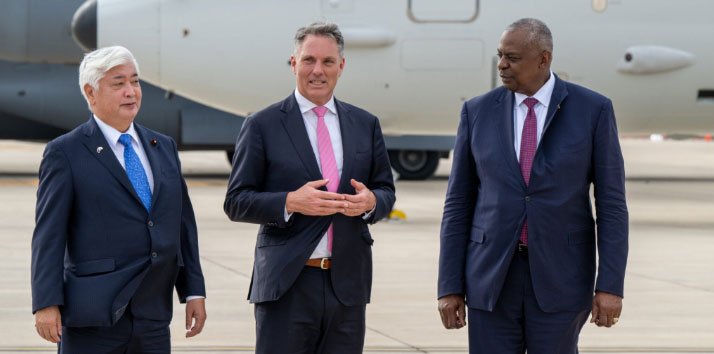Japan, Australia, and the US Strengthen Military Ties with Regular Japanese Marine Rotations
In a significant step toward strengthening military cooperation in the Indo-Pacific region, Japan, the United States, and Australia have agreed to regular rotations of Japanese marines in Australia. This new development, announced during a press conference in Darwin, underscores the growing security ties between the three nations, particularly in response to rising Chinese influence in the region.
Key Developments in the Agreement
US Defense Secretary Lloyd Austin emphasized the importance of Japan’s eventual inclusion in AUKUS Pillar Two, a framework for trilateral defense projects. He noted that this could soon include working on projects related to emerging technologies, though specifics were not revealed.
Australian Defense Minister Richard Marles confirmed that Japan’s Amphibious Rapid Deployment Brigade will now be regularly deployed to Australia. This marks a significant expansion of the trilateral military exercises involving the US, Australia, and Japan. Marles mentioned the aim to increase the complexity and scale of these exercises, including the prominent annual Talisman Sabre and Southern Jackaroo exercises.
Strengthening Trilateral Military Exercises
As part of the new agreement, Japan will participate more actively in key Australian exercises. Starting next year, Japan will be an integral part of Talisman Sabre, Australia’s largest military exercise. Additionally, Japan’s forces will enhance their participation in Exercise Southern Jackaroo, designed to improve trilateral interoperability.
The agreement also includes the integration of Australian forces into Exercise Orient Shield and more extensive involvement in US-Japanese exercises such as Yama Sakura, Keen Edge, and Keen Sword. Last year, 7,000 troops from the US, Japan, and Australia participated in Yama Sakura, a command post exercise aimed at boosting coordination among the three nations.
Expanded Intelligence Sharing and Cooperation
A major focus of the trilateral partnership is enhancing intelligence, surveillance, and reconnaissance (ISR) cooperation. This will include Australian participation in the Japan-US Bilateral Information Analysis Cell (BIAC), established two years ago to share highly classified intelligence between Japan and the US. The new arrangement will allow Japan, the US, and Australia to more effectively collaborate on intelligence, further strengthening regional security efforts.
Future Collaborations and AUKUS
Austin also hinted at Japan’s potential future involvement in AUKUS Pillar Two, specifically in projects involving advanced research and development in areas such as quantum technologies, autonomy, collaborative combat aircraft, and long-range strike capabilities. Austin expressed confidence in the immense opportunities for collaboration between the three nations in these areas.
With these new agreements, the US, Japan, and Australia are reinforcing their strategic military and security ties, particularly as tensions rise in the Indo-Pacific region.
This article was rewritten by JournosNews.com based on verified reporting from trusted sources. The content has been independently reviewed, fact-checked, and edited for accuracy, neutrality, tone, and global readability in accordance with Google News and AdSense standards.
All opinions, quotes, or statements from contributors, experts, or sourced organizations do not necessarily reflect the views of JournosNews.com. JournosNews.com maintains full editorial independence from any external funders, sponsors, or organizations.
Stay informed with JournosNews.com — your trusted source for verified global reporting and in-depth analysis. Follow us on Google News, BlueSky, and X for real-time updates.














